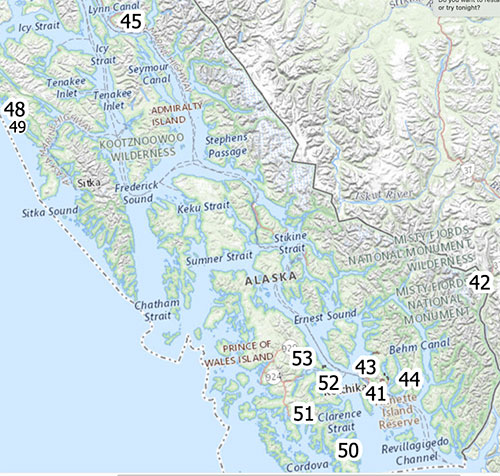
DNR places conditions on 18 mining-contaminated sites; Most contaminated sites located in Southeast Alaska
Posted & Edited By MARY KAUFFMAN
April 14, 2022
Thursday PM
(SitNews) Ketchikan, Alaska - The Alaska Department of Natural Resource in March gave notice it plans to place conditions on state-owned land at 18 sites to prevent the spread of historic mining contamination, while allowing future mining only under specific protective conditions.
The department announced March 21, 2022 that 30-day notice was given of its intent to issue “Leaseholder Location Orders” (LLOs) covering potential future mining activity on approximately 4,600 acres of state tide and submerged lands in Southeast Alaska, the Prince William Sound, and Southwest Alaska, said DNR Commissioner Corri Feige. The impacted tide and submerged lands were contaminated by mining or smelting activities mostly on adjacent private and federal uplands.
“Though these sites are now classified for generally allowed uses like hunting, food gathering or recreation, there may still be valid mining claims being worked, as well as minerals that might interest future miners,” Feige said. “Creating LLOs for these lands enables us to put protections in place that will prevent the spread of historic contamination. This will benefit current and future users and will facilitate clean-up efforts overseen by the Department of Environmental Conservation (DEC).”
Feige emphasized that the contamination on the sites were caused by historic, mining practices that are prohibited by modern state laws and regulations, and that would violate contemporary minerals industry practices.
The Department of Natural Resource’s stated in a news release its decision to issue the LLOs was inspired by the case of the Klag Bay gold mine located in Southeast Alaska, which left contamination after operating on private land on Chichagof Island from 1905 to 1942. The contamination spread to submerged land that became state land in 1959, and is the current site of some small-scale mining, as well as subsistence and recreational activities.
Richard Lessard, section lead for DNR’s Mining, Mineral Property Management, working with Patty Burns, chief of DNR’s Statewide Abatement of Impaired Land (SAIL) section, agree that Klag Bay Mine site is one of many contaminated sites in Alaska where LLOs could be beneficial. Many of the sites contain heavy metals such as lead, mercury or arsenic, that are regulated by DEC. Eleven of the 18 sites are located in Southeast Alaska.
A full list of the 18 mines in the historical mining contamination Leasehold Location Orders was requested by SitNews. The list revealed that 11 sites on the list are located in Southeast Alaska, those are:
• Site 41: Beaver Falls Mine, 300 acres (Ketchikan area)
• Site 42: Riverside Mine, 300 acres (Misty Fjords National Monument area)
• Site 43:
Mahoney Zinc Mine, 130 acres (Ketchikan area)
• Site 44: Sea-level mine, 130 acres (Ketchikan area)
• Site 45: Mexican Mine Mill Tailings & Treadwell Mine Complex, 430 acres (Lynn Canal area)
• Site 48: Hirst Chichagof Mine (Kimshan Cove), 120 acres, (north of Sitka)
• Site 49: Klag Bay Mine, 140 acres (north of Sitka area)
• Site 50: Ross Adams Mine (Bokan Mountain). 150 acres (Prince of Wales area)
• Site 51: Coppermount Smelter, 170 acres, (Prince of Wales area)
• ite 52: Hadley Smelter, 550 acres (Prince of Wales area)
• Site 53: Salt Chuck Mine,
410 acres (Prince of Wales area)
Quoting a news release, the LLOs will allow DNR to put stipulations into lease agreements requiring miners to take steps to prevent release of the historic contamination, even as they conduct mining activities. LLOs do not impact valid and existing mining claims. However, the LLOs inform existing claim holders of the contamination on their claim sites, enabling them to take appropriate preventative steps. Lessard said issuing the LLOs on these 18 sites will have several benefits, including:
- protecting subsistence and recreational users of the land
- keeping the areas open to mining,
- ensuring miners know the personal health and financial risks of operating on the sites
- letting the state impose site-specific risk-mitigating conditions on future mining
- facilitating coordination of future mining with efforts to clean up historic contamination
- empowering DNR to keep a thorough record of activity on the sites, essential to future clean-up activities
- streamlining coordination between DNR and DEC for remediation and mining activities
- reducing the state’s risk of liability and expense for site clean-up
- establishing a model for management and remediation of historically contaminated state tidelands
On the Web:
Download map of 18 mines listed in the historical mining contamination Leasehold Location Orders (pdf)
Downlad description/location of Historical Mining Contamination Leasehold Location Orders - table outlining each. (pdf)
Source of News & Maps:
Alaska Department of Natural Resource
www.dnr.alaska.gov
| Representations of fact and opinions in comments posted are solely those of the individual posters and do not represent the opinions of Sitnews. |
Send a letter to the editor@sitnews.us
Contact the Editor
SitNews ©2022
Stories In The News
Ketchikan, Alaska
|
Articles &
photographs that appear in SitNews are considered protected by copyright
and may not be reprinted without written permission from and
payment of any required fees to the proper freelance writers and subscription services.
E-mail your news &
photos to editor@sitnews.us
Photographers choosing to submit photographs for publication to SitNews are in doing so granting their permission for publication and for archiving. SitNews does not sell photographs. All requests for purchasing a photograph will be emailed to the photographer.
|
|

